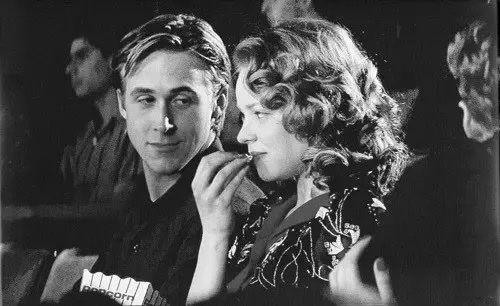Gestures and Movement: Conveying Meaning Through Actions
- khailareyno
- Apr 22, 2024
- 7 min read
Updated: Apr 28, 2024

The Notebook (2004)
In screenwriting, gestures are a powerful tool for engaging the audience and adding depth to characters. They add a layer of depth to characters, revealing their personalities, emotions, and intentions through physical actions. Gestures can range from subtle movements like a raised eyebrow or a smirk to more dramatic gestures like a sweeping arm movement or a clenched fist. These gestures not only make characters more relatable and three-dimensional but also help convey information and subtext without relying on dialogue.
Let's take a closer look at how gestures and movement can be harnessed effectively in screenwriting:
Revealing Character Traits
Gestures and movement can reveal a character's personality traits and emotional state. For example, a character who fidgets nervously may convey insecurity or anxiety, while a character who stands tall and gestures confidently may convey confidence and assertiveness.
Gestures and movement are invaluable tools for revealing character traits in screenwriting. They offer a visual language that can communicate aspects of a character's personality, motivations, and inner world without the need for explicit dialogue. For instance, a character who uses big hand movements when they talk might seem very passionate or expressive. On the other hand, a character who moves very carefully and precisely might seem very careful or in control.
Additionally, gestures are also powerful tools for conveying a character's emotional state and confidence level in screenwriting. A character who stands tall with open body language, such as relaxed shoulders and direct eye contact, can be perceived as confident and self-assured. Their posture suggests a sense of ease and comfort in their surroundings, indicating a strong sense of self-confidence. Conversely, a character who fidgets or avoids eye contact may be seen as nervous or insecure. These subtle movements can convey a lack of confidence and a feeling of discomfort or unease.
Furthermore, gestures and movement can serve as cultural cues, providing insights into a character's background, upbringing, or social status. For example, the way a character greets others can reveal cultural norms and values. A character who greets with a formal bow may come from a culture where respect and tradition are highly valued. On the other hand, a character who greets with a casual handshake may be perceived as more relaxed and informal, suggesting a more laid-back upbringing or social demeanor.
Enhancing Dialogue
Gestures and movement can significantly enrich verbal communication in screenwriting by providing additional layers of meaning and subtlety to dialogue. For instance, when a character shrugs while saying "I don't know," it can effectively convey a sense of uncertainty or lack of knowledge. This simple gesture adds depth to the dialogue, helping the audience understand the character's mindset and emotions more fully.
Similarly, when a character points emphatically while giving directions, it can convey a strong sense of confidence and authority. The gesture reinforces the character's words, making their instructions more convincing and impactful. These subtle movements can enhance the overall effectiveness of the scene, making it more engaging and memorable for the audience.
Adding Subtext
Gestures are key to conveying subtext in a scene, adding depth to the storytelling by providing layers of meaning. For instance, when a character nervously taps their fingers on a table while speaking, it can reveal underlying anxiety or impatience, enriching the dialogue. Likewise, if a character clenches their fists while appearing calm, it may suggest hidden anger or tension, highlighting inner conflict that contradicts their outward calmness.
Furthermore, gestures can be used to convey hidden emotions or intentions that are not explicitly stated in the dialogue. A character who forces a smile while saying something unpleasant may reveal their true feelings of discomfort or insincerity. Similarly, a character who avoids eye contact while speaking about a sensitive topic may indicate feelings of guilt or shame.
Additionally, gestures can be used to create dramatic irony, where the audience is aware of something that the characters are not. For example, a character who gestures towards an object of importance without realizing its significance can foreshadow future events, adding suspense and intrigue to the scene.
Establishing Relationships
Gestures and movement play a crucial role in establishing relationships between characters in a screenplay. These nonverbal cues help to define the nature of their connection, whether it's one of intimacy, conflict, dominance, or submission. For example, a character who gently touches another's arm might convey a sense of affection or closeness, creating a warm and intimate atmosphere. On the other hand, a character who avoids making eye contact could be signaling discomfort or unease, hinting at underlying tension or conflict in the relationship. These subtle actions provide important context for the audience, helping them understand the dynamics between characters beyond what is explicitly stated in the dialogue.
Creating Visual Interest
Gestures and movement in screenwriting are like adding details to a painting, making the story more vibrant and engaging. In movies, where what you see is as important as what you hear, these actions help keep scenes interesting, especially when there's a lot of talking. They bring life to the characters and make the audience pay closer attention.
Imagine a scene where two characters are engaged in a heated argument. Instead of relying solely on dialogue to convey the tension, the screenwriter can incorporate gestures like pointing fingers, clenched fists, or pacing back and forth. These movements not only add a visual element to the scene but also intensify the emotional impact, drawing the audience deeper into the conflict.
Gestures and movement can also be used to create dynamic and engaging scenes that hold the audience's attention. For example, a character who moves a lot while telling an exciting story can make it feel like the audience is right there with them. Similarly, a character who moves gracefully across the screen can add a sense of elegance and fluidity to a scene, making it more visually appealing.
Setting the Scene
Lastly, gestures and movement can be powerful tools in setting the scene and establishing the environment in which characters are interacting. By incorporating these elements into a screenplay, screenwriters can provide subtle cues that help viewers visualize the surroundings and atmosphere of a scene. For instance, a character who brushes dust off a table might indicate that they are in a dusty or neglected environment, suggesting a setting that is old, rundown, or abandoned. This simple gesture can help to create a more immersive experience for the audience, allowing them to imagine the scene more vividly and feel more connected to the story.
Wondering how to incorporate gestures into your writing? Here are some tips for doing it effectively:

Use Gestures to Reveal Emotions
When writing, consider the power of gestures to convey the emotions of your characters. Rather than directly stating how a character feels, show it through their actions.
Instead of outright saying, "John was angry," you can describe John clenching his fists, his face turning red, or his jaw tightening. These actions convey his anger without directly stating it.
Use Gestures to Enhance Dialogue
Instead of relying solely on words to convey meaning, gestures can add layers of nuance and subtext to the conversation.
Incorporating gestures into dialogue can also help clarify the meaning behind the words. For instance, a character who says, "I love you," while placing a hand over their heart, adds depth and sincerity to the declaration. Additionally, gestures can help to break up long stretches of dialogue, making the scene more visually interesting and dynamic.
Describe Body Language
When describing a character's actions, incorporating details about their body language can enrich the scene and provide deeper insight into their emotions and state of mind.
For example, rather than simply stating "She said nervously," you could paint a more vivid picture with something like, "She twisted her hands together, avoiding eye contact, her voice barely above a whisper." This approach not only conveys the character's nervousness but also allows the reader to visualize the scene more vividly, making the character's emotions more palpable and relatable.
Consider the Setting
Using gestures and movement to establish the setting is an effective way to bring the environment to life and immerse the audience in the scene. By describing how characters interact with their surroundings, you can create a vivid picture of the setting without relying solely on descriptive language.
For example, if your characters are in a crowded market, you could describe them dodging through the crowd, bumping into people, and navigating the bustling stalls. This not only conveys the busy and chaotic nature of the market but also adds movement and action to the scene, making it more dynamic and engaging.
Similarly, you could show characters haggling with a vendor, using gestures to negotiate and communicate. This not only establishes the setting as a market but also provides insight into the characters' personalities and motivations. Are they skilled negotiators, or do they struggle to get a good deal? Do they approach the situation with confidence, or are they hesitant and unsure?
Be Subtle
When it comes to using gestures in writing, less is often more. While gestures can add depth and nuance to your characters and scenes, overdoing it can make your writing feel forced or unnatural. It's important to use gestures sparingly and make sure they are appropriate for the character and the situation.
Instead of peppering every dialogue with gestures, choose key moments where a gesture can enhance the scene or reveal something important about the character. For example, a character who is usually reserved might use a subtle gesture to convey a deep-seated emotion, such as a slight tremble in their hand when they are nervous or a gentle touch on someone's arm to show empathy.
When using gestures, consider the context of the scene and the personality of the character. A flamboyant character might use big, exaggerated gestures to express themselves, while a more introverted character might use smaller, more subtle movements.
You can find examples of how to describe gestures in writing by following this link:
https://writingtipsoasis.com/how-to-describe-gestures-in-writing/
When incorporating gestures into your writing, it's important to ensure that they feel natural and seamless within the context of your character and the narrative. The gestures should complement the scene, enriching it by providing additional layers of meaning and depth to the characters. However, they should not overshadow or distract from the main action or dialogue. Instead, they should enhance the overall storytelling experience, making the characters more relatable and the scenes more vivid and engaging for the reader.


